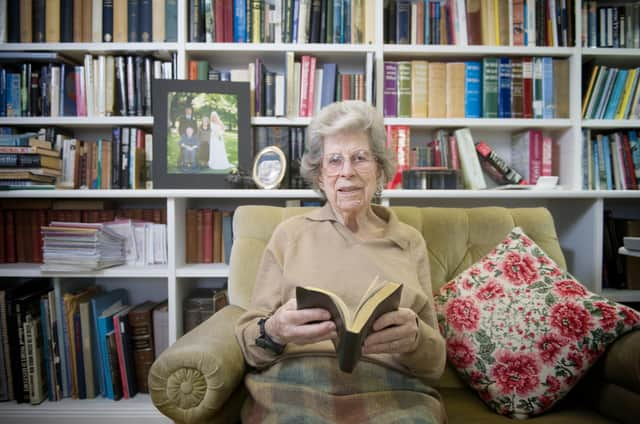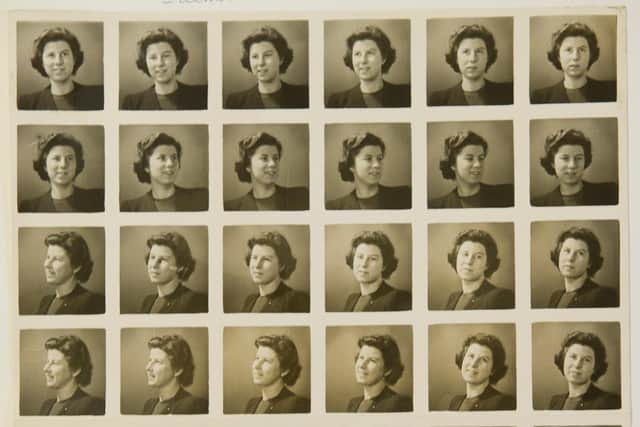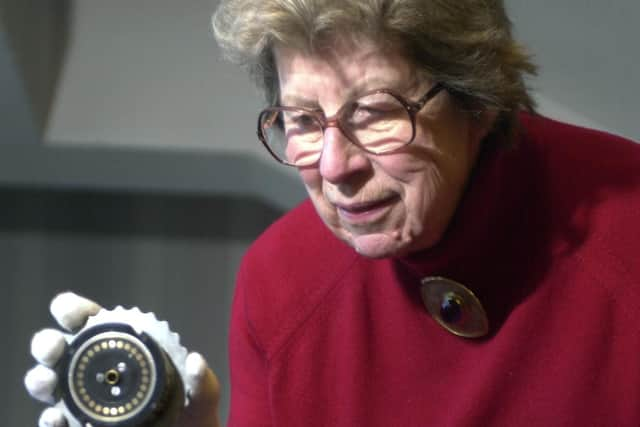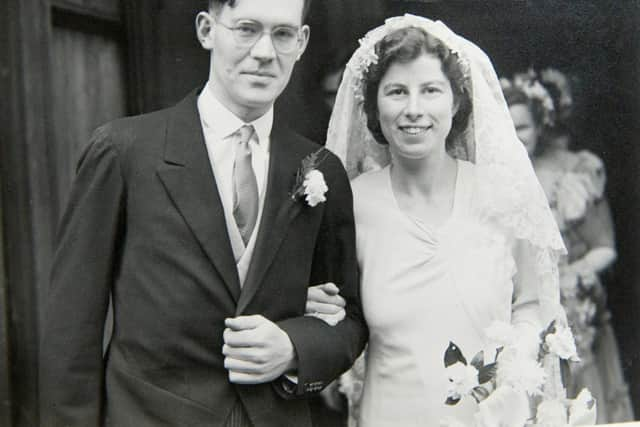Bletchley Park codebreaker who helped change course of World War II dies aged 97


The veteran, who spent more than 20 months helping to decipher German codes at the top secret facility, died on Monday at an Edinburgh care home. She was 97, and had tested positive for Covid-19 shortly before her death.
In peacetime, Mitchell produced pioneering research into the impacts of divorce on children, work which would shape and inform legislative reform in Scotland. But it was decades previously, while barely out of her teenage years, that she played an integral role in bringing about that peace, thanks to her work in Hut 6, a ramshackle wooden structure home to some of Bletchley Park’s brightest minds.
Advertisement
Hide AdAdvertisement
Hide AdThere, for nine hours a day, six days a week, from September 1943 until the final exultant hours of VE Day, the young Oxford graduate would create complex diagrams used to break strings of incomprehensible Enigma code used by the Nazis.


Her diary entry four days after Christmas 1943 captured the frantic rhythm of a typical shift, as well as something of her character. “Worked like the devil all day,” she observed in her spidery handwriting. “Good fun.”
James Turing, the great-nephew of Alan Turing, the revered mathematician and computer scientist who devised Bletchley’s codebreaking machines, said Mitchell’s experience echoed that of his great-uncle’s, and predicted she would “long remain an inspiration to many.”
Tessa Dunlop, the broadcaster, writer, and historian, who interviewed the nonagenarian for her 2015 book, ‘The Bletchley Girls’, said her natural intelligence set her apart.
Advertisement
Hide AdAdvertisement
Hide Ad“The majority of the girls at Bletchley were part of a factory - a conveyor belt, really - to deal with the component parts of codebreaking, but Ann was exceptional in the work she did finding the formula for the codebreaking machines,” Ms Dunlop explained.


“She was a bright woman, an old school Brit, and she was recruited through the Oxbridge milieu. But she wasn’t a posh girl. She was a bluestocking, and she found the whole experience stimulating and enjoyed it.
“Ann was just a kid, but she was discreet, intelligent, and modest, and although she would never describe herself as a codebreaker, she was recruited for her mathematical ability.”
Around 10,000 people worked at Bletchley Park at the height of its operations, with women accounting for close to three quarters of its workforce. But with the loss of Mitchell, just three months after the death of Ailsa Maxwell, her colleague in Hut 6, their ranks have dwindled further. The average age of Bletchley’s veterans now stands at 97, and a reunion held last September to mark the 80th anniversary of the beginning of the war was attended by just 95 former staff.
Advertisement
Hide AdAdvertisement
Hide AdMitchell’s name is on the Bletchley Park Trust’s roll of honour, and with good reason. She was a key part of its remarkable history, though for decades, whenever asked about her service at the Buckinghamshire facility, she relied on her cover story, describing her wartime contribution as office or secretarial work.


It was only in the 1970s, after details of Bletchley Park’s crucial contribution to the Allied effort began to seep into the public domain, that she acknowledged her secret role, embarking on a series of talks around the country.
MItchell was born and brought up in Oxford, and secured a scholarship at the independent Headington School, where even the biases of those in charge could not discourage her from improving upon a natural aptitude for numbers
“My headmistress firmly told my parents that mathematics was not a ladylike subject,” she recalled. “However, my parents overruled her and I pursued my chosen path.”
Advertisement
Hide AdAdvertisement
Hide AdShe became one of only five women accepted to read maths at Oxford in 1940. Upon her graduation, she was called up by the Foreign Office to work as a “temporary assistant” on a salary of £150. In hindsight, the vagueness of her job title betrayed the importance of the highly classified work Mitchell was about to undertake.
Sustained by little more than a cup of Oxo and a boiled egg most mornings, she cycled the 10 mile commute from her billet to Bletchley, where she would identify links between letters in the German code and ‘cribs’ - commonly used words or phrases in the transmissions. The information would then be used by Turing and teams of cryptologists manning the electromechanical bombe machines nearby in Hut 8.
With the Germans changing every code used by every unit at midnight, Mitchell and her colleagues had to start afresh each day. There were no complaints. She compared the work to completing a crossword, by joining links and chains of letters.
“We were trained to make menus - a sort of program – on the machines,” she reflected in 2013. “I don’t suppose we had ever heard the word ‘computer’; in fact it probably had not been invented then.”
Advertisement
Hide AdAdvertisement
Hide AdJames Turing, the founder and chief executive of the Turing Trust, an Edinburgh-based charity that continues his great uncle’s legacy by providing reused computer and teacher training in sub-Saharan Africa, said Mitchell had to contend not just with complex German encryptions, but societal stigmas at home.
He said: “One of the remarkable impacts that Ann had through her role at Bletchley Park was in helping to overcome prejudices typical of the time which would hold people back from achieving their potential.
“In spite of the additional challenges she was forced to overcome she demonstrated how these prejudices could be overcome enabling her to contribute in a vital way to one of the most challenging aspects of Enigma codebreaking – devising menus - a form of program, if you like - for the bombes.
“Her experience was in many ways like that of Alan Turing and will long remain an inspiration to many.”
Advertisement
Hide AdAdvertisement
Hide AdCome peacetime, Mitchell, nee Williamson, married the newly demobbed Angus Mitchell, a war hero who was decorated with the Military Cross, and later, became a knight in the Dutch Order of Oranje-Nassau, as well as a Chevalier of the Legion d’Honneur.
The couple settled in Edinburgh, raising four children: Jonathan, Charlotte, Catherine, and Andy. The latter said that when the family first discovered its matriarch was an cog in the machine which broke the Nazi encryption system, it gave everyone cause to reappraise the past.
“Up until then, we had heard stories of my father’s wartime exploits, which as a wee boy, were fascinating, because he was on active service just after D-Day with the Inns of Court Regiment.,” Andy explained.
“I think he was surprised to find out his wife had a rather more significant role in the war than he had ever suspected.
Advertisement
Hide AdAdvertisement
Hide Ad“The more we found out, the more amazed we were at how deeply involved she had been in the codebreaking. It wasn’t just pushing paper about - it was a genuinely high-pressure, intellectual job.”
If civvy street proved a shade beige compared to her tenure at Bletchley, Mitchell continued to challenge herself and pursue new interests which benefited the rest of society.
After training as a volunteer counsellor, she obtained a second degree, this time an MPhil from the University of Edinburgh, and embarked on a series of groundbreaking social policy research into the impact of divorce on children.
The discipline required, she told The Scotsman in 2015, was not entirely unrelated to her toil at Bletchley.
Advertisement
Hide AdAdvertisement
Hide Ad"The kind of mind that looks for a crib at Bletchley Park is the kind of mind that looks for a father or mother and will keep looking,” she reflected. “Putting families back together and solving mysteries, there's a link.”
In her eighth decade, Mitchell also established herself as an author, writing acclaimed local history books on Scotland’s capital, as well as a biography of her mother, Winifred.
Andy, a sports historian, said that his mother attended Bletchley Park reunions over the years, and enjoyed the recognition and appreciation paid to her in the twilight of her life.
“There was so much interest from the media, films, and books,” he said. “People were, and still are, so keen to hear about this episode in history, because for so long it was a hidden part of the war effort, and here were ordinary people doing something that was incredibly important.”
Advertisement
Hide AdAdvertisement
Hide AdDunlop said that Mitchell’s rich life meant that she was not defined by Bletchley Park, but she relished looking back on it in her later years.
“Some of the Bletchley women spoke about how they experienced a resurrection in old age as people learned about what they had done,” she said. “But I don’t think Ann ever needed that. She was an accomplished woman in every sphere - a mother of four, a counsellor, her research into divorce.
“As we get older and more societally invisible, we remain the same people, and I think with great poise and modesty, Ann enjoyed speaking about her experiences and receiving recognition.
“And who wouldn’t want to be applauded for their part in a mission that was a success and has subsequently been lauded by history?"
Advertisement
Hide AdAdvertisement
Hide AdA message from the Editor:Thank you for reading this story on our website. While I have your attention, I also have an important request to make of you.With the coronavirus lockdown having a major impact on many of our advertisers - and consequently the revenue we receive - we are more reliant than ever on you taking out a digital subscription.Subscribe to scotsman.com and enjoy unlimited access to Scottish news and information online and on our app. With a digital subscription, you can read more than 5 articles, see fewer ads, enjoy faster load times, and get access to exclusive newsletters and content. Visit https://www.scotsman.com/subscriptions now to sign up.
Our journalism costs money and we rely on advertising, print and digital revenues to help to support them. By supporting us, we are able to support you in providing trusted, fact-checked content for this website.
Joy Yates
Editorial Director
Comment Guidelines
National World encourages reader discussion on our stories. User feedback, insights and back-and-forth exchanges add a rich layer of context to reporting. Please review our Community Guidelines before commenting.